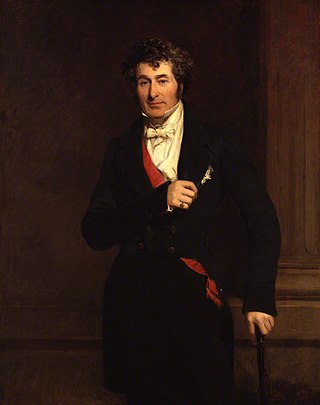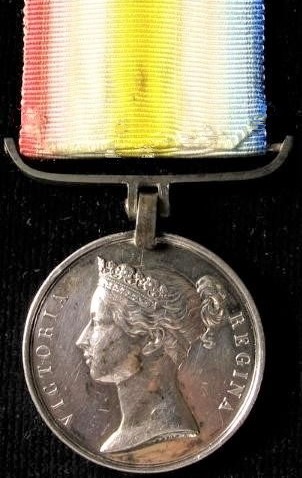
Edward Law, 1st Earl of Ellenborough, was a British Tory politician. He was four times President of the Board of Control and also served as Governor-General of India between 1842 and 1844.

General Sir Charles James Napier, was an officer and veteran of the British Army's Peninsular and 1812 campaigns, and later a Major General of the Bombay Army, during which period he led the military conquest of Sindh, before serving as the Governor of Sindh, and Commander-in-Chief in India.
Miani Maluk or Meeanee is a village in Sindh, Pakistan, on the east side of river Indus. It was the site of the Battle of Miani, which British won and made Sindh a part of British India.

Scinde Dawk was a postal system of runners that served the Indus Valley of Sindh, an area of present-day Pakistan. The term also refers to the first adhesive postage stamps in Asia, the forerunners of the adhesive stamps used throughout India, Burma, the Straits Settlements and other areas controlled by the British East India Company. The name derives from the words "Scinde", the British spelling of the name of the province of Sindh, and "Dawk", the anglicised spelling of the Hindustani word "Dak" or Post.

The Battle of Miani was a battle between forces of the Bombay Army of the East India Company, under the command of Charles Napier and the Baluch army of Talpur Amirs of Sindh, led by Mir Nasir Khan Talpur. The battle took place on 17 February 1843 at Miani, Sindh, in what is now modern-day Pakistan. This battle and the subsequent Battle of Hyderabad eventually led to the capture of parts of Sindh region, first territorial possession by the East India Company in what is the modern-day state of Pakistan.

Lieutenant-General Sir James Outram, 1st Baronet was a British general who fought in the Indian Rebellion of 1857.

The Battle of Hyderabad, sometimes called as the Battle of Dubbo was one of the major campaigns of the British against then Sindh led by the Talpurs which was fought on 24 March 1843 between the forces of the British East India Company and the Talpur Mirs of Sindh near Hyderabad, Sindh, Pakistan. A small British force, led by Captain James Outram, were attacked by the Talpurs and forced to make a fort of the British residence, which they successfully defended until they finally escaped to a waiting river steamer. After the British victory at Meeanee, Sir Charles James Napier continued his advance to the Indus River and attacked the Sindh capital of Hyderabad. Hyderabad was defended by 20,000 troops and Baloch tribes under the command of His Highness Mir Sher Muhammad Khan Talpur "Sher-i-Sindh" and Hosh Mohammad Sheedi. Charles Napier with a force of only 3,000 men but with artillery support stormed the city. During the battle, Hosh Mohammad Sheedi was killed and his forces routed; Talpurs resistance collapsed and Sindh came under British control.

Brigadier-General John Jacob CB was an officer of the British East India Company who served in colonial India for the major portion of his career. He is known for the cavalry regiment called 36th Jacob's Horse, and for founding the town of Jacobabad, in Sind province of British India, where he planned and supervised the transformation of thousands of acres of desert into arable land over the course of twenty years. The scale of progress and prosperity his works brought to the region can be appreciated by comparing those regions' relative prosperity compared to areas which were not under his administrative jurisdiction.

Mir Sher Muhammad Talpur was a Talpur prince who belonged to the Mirpur Khas house of the royal Talpur dynasty. The son of Mir Ali Murad Talpur, the founder of Mirpur Khas, he was born in 1810. After becoming ruler of the Talpur dynasty, his reign saw a conflict with the British East India Company, who launched an invasion of the province of Sindh under the auspices of General Charles James Napier, aiming to annex the entire region. On 24 March 1843, troops under his command fought against a Company force in the Battle of Hyderabad; the British emerged victorious, and captured the city of Hyderbad soon after. Talpur then retreated into the countryside, where forces loyal to him and equipped largely with muskets waged a guerrilla campaign against the British, whose efforts to counter this led Napier to coin the word "counterinsurgency". He eventually died on 24 August 1874.

The Talpur dynasty were rulers based in Sindh. Four branches of the dynasty were established following the defeat of the Kalhora dynasty at the Battle of Halani in 1783: one ruled lower Sindh from the city of Hyderabad, another ruled over upper Sindh from the city of Khairpur, a third ruled around the eastern city of Mirpur Khas, and a fourth was based in Tando Muhammad Khan. The Talpurs were ethnically Baloch. For most of their rule, they were subordinate to the Durrani Empire and were forced to pay tribute to them.

The Sind Division was the name of an administrative division of British India located in Sindh.

General Hosh Muhammad Sheedi Qambrani or Hoshu Sheedi was an Askari unit, and also supreme commander of Sindh's Talpur army led by Mir Sher Muhammad Khan Talpur. Hoshu Sheedi fought against the British forces under Sir Charles James Napier at the Battle of Hyderabad, and was killed on-battle in March 24, 1843. Hosh Muhammad belonged to the African-descent Siddi community of Sindh, Pakistan. Before his death in the Battle of Hyderabad, he called out the famous slogan:
مرويسون پر سنڌ نه ڏيسون
Marvesoon par Sindh na desoon
(We will die but not give Sindh [to others])

The 36th Jacob's Horse were a unit of cavalry of the British Indian Army.
N Parachute Battery Royal Horse Artillery is a Tactical Group Battery of 7th Parachute Regiment Royal Horse Artillery. They are currently based in Albemarle Barracks in Northumberland.

The 125th Napier's Rifles was an infantry regiment of the British Indian Army. At various points in history it was also known as the 1st Extra Battalion Bombay Native Infantry, the 25th Regiment of Bombay Native Infantry (1826–1889) and the 25th Bombay Rifles. Amalgamated with five other regiments in 1922, it is now the 5th Battalion, Rajputana Rifles. The Battalion celebrated its bicentenary on 17 Feb 2020. The Battalion is now known as 5th Battalion the Rajputana Rifles (Napiers) or 5 RAJ RIF.
Mir Nasir Khan Talpur was the last Amir of the land that included Sindh and parts of present-day Balochistan and was one of the most active administrators after the decline of the Mughal Empire. He made Hyderabad the capital of his empire and constructed two forts in the city known as the Pakka Qilla and the Kacha Qilla and he also built the Maula Ali Qadam Gah, a Shia shrine at the center of the city. He was a strong follower of the Sufi tradition. He donated a lot of his personal wealth to the Tomb of Shah Abdul Latif Bhittai at Bhit Shah. He and his 30,000 forces were defeated by the forces of the British Empire led by Charles Napier at the Battle of Miani.

The Scinde Medal was authorised on 22 September 1843 and issued to soldiers of the Honourable East India Company, the 22nd Regiment of Foot of the British Army and members of the Indian Navy who crewed the Indus Flotilla, who participated in Major General Sir Charles Napier's conquest of Scinde between 1842 and 1843.
Sir Henry Gee Roberts, K.C.B. was a British major general and political agent who served with British East India Company and afterwards with British Raj in India.

















